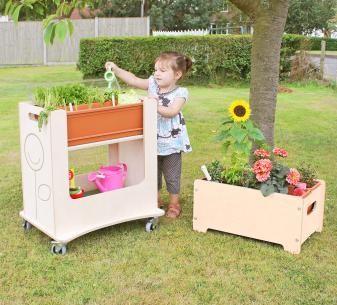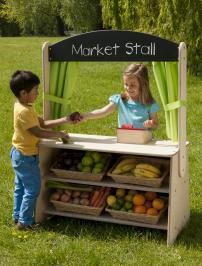A vegetable patch at school is one of the greatest teaching resources you will find and will provide great satisfaction and enjoyment to everyone involved. Not only is it becoming an increasingly popular extra curriculum activity it’s being introduced in to teaching across the board.
Growing food can teach children all sorts of topics such as soil, nutrition, science and life cycles of vegetables or plants. It also teaches them about the types of creatures that are naturally attracted to the garden and different habitats. It raises a child’s awareness of the seasonal changes and the variety of fruit and vegetables which can be grown.
Not only do children become more aware of the different types of food that can be grown, being involved in growing food can increase their interest in eating the food.
If you want to grow vegetables and gain real interest from the children then it’s probably best to start with fruits and vegetables that are easier to sow and grow and that grow at a quicker rate. Faster results will gain children’s interest and leave them wanting more.
Some of the best vegetables to grow are those that:-
- Are easy to sow, especially those with large seeds like courgettes.
- Germinate quickly, to keep those short attention spans occupied.
- You can sow in situ, so you do not have the trouble of transplanting.
- Produce a crop quickly.
- Require minimum maintenance other than watering and feeding.
- Will continue cropping.
Starting a Vegetable Garden
A vegetable patch can be started anywhere, it can be anything from a large sunny garden to just a few pots placed on a patio. The ideal situation for fruit and vegetables to flourish includes warmth, sunlight, shelter, water and some fertile soil.
Your patch should be open but not overexposed and overshadowed.
Raised Flowerbeds
The traditional allotment style vegetable patch style is rows of vegetables spread out across a large patch of soil, this is not always possible in school grounds so a bed system will probably work better.
Raised beds can be made with simple planks of wood butted together to create an area which can be easily attended too. You can also divide this flower bed up into different sections for different vegetables.
This system means you can complete all the work needed easily from the path without standing on the soil.

Creative flower pots
If your school is a little short on soil space you can create a growing area with just about anything that has sides.
Ask parents or local business for materials that may be useful to your vegetable patch. These can include old chimney pots, wooden pallets, old sinks or bath tubs, large cooking tins, dustbins or even bricks that you can make a raised bed with.
The possibilities are endless and most of the time it is just junk that people no longer need – it’s also great for adding a little character to your veggie patch.
Vegetables to Grow
It is a good idea to start small and just grow 2 or 3 vegetables that are reliable and easy to grow. After all you don’t want your first crop to be unsuccessful as this is not likely to gain the interest of the children.
The crops you choose to grow should also coincide with your school term times which sounds a lot more complicated than it actually is. Ideally you want to harvest your crop by mid-July or ensure its going to last through the summer holidays until September.
In order to avoid using chemicals near children, your vegetable garden should, ideally be organic. If chemicals are needed then ensure the supervising adults carries out these tasks.
Fruit & Vegetables to consider growing that are reliably fast to harvest;
- Tomatoes – Can be planted late May and usually take around 12 weeks to fully grow.
- Carrots - Sow early carrots during March, April or June. They can be harvested 11-12 weeks later between June and July or in September.
- Courgette – Can be planted early spring and only take around 10 weeks to harvest.
- Strawberries – Can be planted April to June and harvested between June – September.
- Runner Beans – Plant between April and June and harvest between June – October.
- Peas - Sow early peas between March and mid-April or in June to July. These can be harvested 12 weeks later in June or in September to October.
- Lettuce - Start sowing from mid-March and harvest between 8-14 weeks later.
Our Indoor/Outdoor School Mini Garden provides everything that you need to start growing fruit and vegetables. The mini garden has plenty of storage for gardening supplies and equipment and is supplied with a waterproof tray, jiffy pot strips and propagator lid, deep plant pot and drip trap.
Suitable for use with the Outdoor Planter which is perfect when your seeds have sprouted and need to be transferred for continued growth.
You can set up an outdoor market stall with our Outdoor Shop & Theatre Set. Perfect for when the children have harvested all the crops they can take them to market and pretend to sell their produce. Ideal for developing further maths and communication skills.
Other things to consider

Another great source of organically produced food is chickens! Many schools across the UK now keep chickens within the school grounds.
Not only does it teach children about where their food comes from but also teaches them about care and responsibility.
The children can take it in turns to feed to chickens, and collect the eggs. The eggs can be used either in the school kitchen or can be used as an ingredient within the cooking classes to make cakes and tasty treats.
At Early Learning Furniture we are experts in early years’ education resources including classroom furniture, school dining furniture and school play equipment. For more information about our products please contact us or call us on 01733 511121.
Permalink:
https://www.earlylearningfurniture.co.uk/blog/growing-vegetables-at-school.aspx